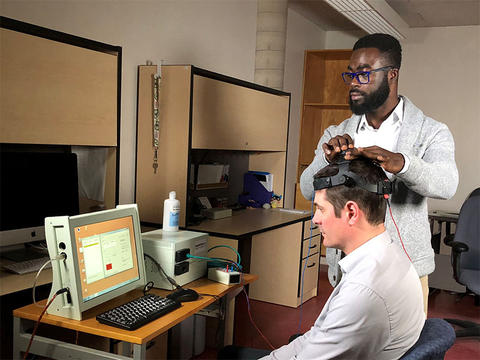Macular-degenerative diseases are a leading-cause of blindness worldwide and rates of the age-related form (AMD) are growing exponentially; it’s estimated that 288 million people will be living with AMD by 2040.
Many forms of macular degeneration are considered untreatable. Where treatment does exist, it focuses on the eye itself and it’s limited to preventing further vision loss.
But what if there was another way to treat macular degeneration? One that goes beyond the retina to the visual cortex itself.
This is the premise of a new research project at the School of Optometry & Vision Science (WOVS), led by Dr. Ben Thompson. Thompson and an interdisciplinary team of collaborators from the University of Waterloo and Hong Kong Polytechnic University plan to demonstrate how neuro-modulation and perceptual learning can improve how the brain processes visual information. And in the process, they hope to introduce a new way of looking at low vision treatment.

Dr. Ben Thompson is leading research to demonstrate how neuro-modulation can improve how the brain processes visual information.
Changing the adult brain
The project, which was recently granted funding by Denmark’s Velux Foundation, evolved from Thompson’s earlier work in perceptual learning (learning that takes place through the repetition of sensory tasks) and vision.
During his post-doctoral training at UCLA, Thompson was introduced to an emerging field that used transcranial magnetic stimulation (TMS) to induce neuroplasticity, the brain’s ability to change over time as a result of experience.
“In children,” Thompson explains, “the brain has a very high level of plasticity and can fine-tune its circuitry to its environment; it can change depending on the information it’s receiving. But it’s not really desirable to do that all through your life, so it it settles into a more fixed state in adulthood. And until fairly recently, many scientists believed that the adult brain was unable to change.”
Researchers at UCLA were using TMS as a neurorehabilitation technique for stroke patients. They applied repetitive stimulation to alter the balance of activity in different brain areas in order to enable the brain increase its plasticity and to recover more effectively.
This technique prompted the brain to overcome the damage caused not only by the stroke, but also the natural barrier between the two hemispheres that prevents spontaneous electrical activity propagating throughout the brain.
Say you have a stroke on the left side, and it affects your right arm,” Thompson explains. “Part of the loss of activity in your right arm is because you’ve lost some cells on the left hemisphere, but also because the two hemispheres inhibit each other.”
Thompson wondered if this same restorative effect could be applied to another condition where part of the brain’s functions are inhibited. A condition that had previously been considered untreatable in adults: amblyopia.
Thompson explored this problem during a second post-doctoral term at McGill. The results were positive; brain stimulation allowed the amblyoptic eye to see.
“That study was interesting from two perspectives,” Thompson says. “It opened up a new possibility for neurorehabilitation that we’re still pursuing. It also demonstrated that the adult brain is able to change, to use information from the amblyoptic eye with just a 15-minute intervention. The effect was temporary, but it showed that that even though the adult brain is less plastic, there are still interventions that can be used to reopen plasticity for a period of time.”

PhD student Richard Donkor (right) and Dr. Ben Thompson demonstrate brain stimulation technology that may lead to new treatment options for macular-degenerative diseases.
From amblyopia to AMD
This ability via brain stimulation to promote plasticity and to overcome the suppression of certain functions is a key factor the new Velux study. It also opens the door to new approaches in the treatment and rehabilitation of low vision.
“Typical treatments try to arrest the progression of the disease. Our research will actually improve vision in people with macular degeneration by enhancing processing of residual visual input, not in the eyes, but within the brain.”
The research team hopes to retrain the brains of people with macular degeneration to do two things: better use the peripheral parts of the retina that aren’t directly affected by the disease and overcome a phenomenon called crowding.
“In peripheral vision we have lower resolution but we also have crowding, where adjacent objects interfere with each other. And there’s evidence to suggest that that isn’t just because we have less detectors in this part of the periphery but that there are mechanisms in the brain that conflate adjacent objects and mix them up.”
Just as brain stimulation disrupts the suppression of information between the brain’s hemispheres and within the brain in amblyopia, the team believes that it can also disrupt the patterns of inhibition that cause crowding.
Translating research results into clinical practice
The project will draw on the neuroscience and clinical expertise of scientists at both the School and at the Hong Kong Polytechnic University, an institution also known for innovative vision research.
Team members include researchers affiliated with Waterloo’s Centre of Sight Enhancement and Hong Kong’s Vision Rehabilitation Clinic.
“Through these links, we’ll be able to make patients with low vision aware of the research and ensure that the results can be translated directly into international clinical practice,” Thompson says.
If this project is successful, he notes, it will alter the way we think about the adult brain, proving that it can indeed change.
It will promote further study into the use of perceptual learning and open up a new field of research in the area of low vision rehabilitation.
And most importantly, it will help millions of people regain their sight.






